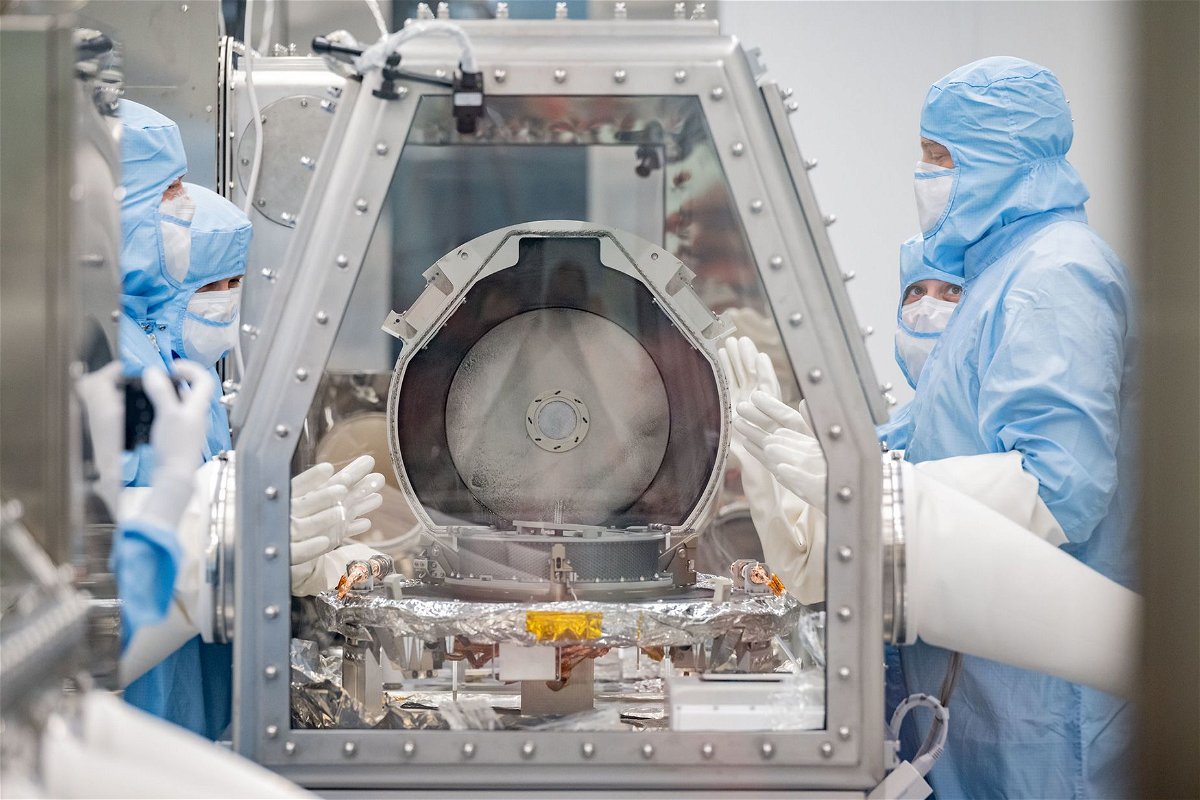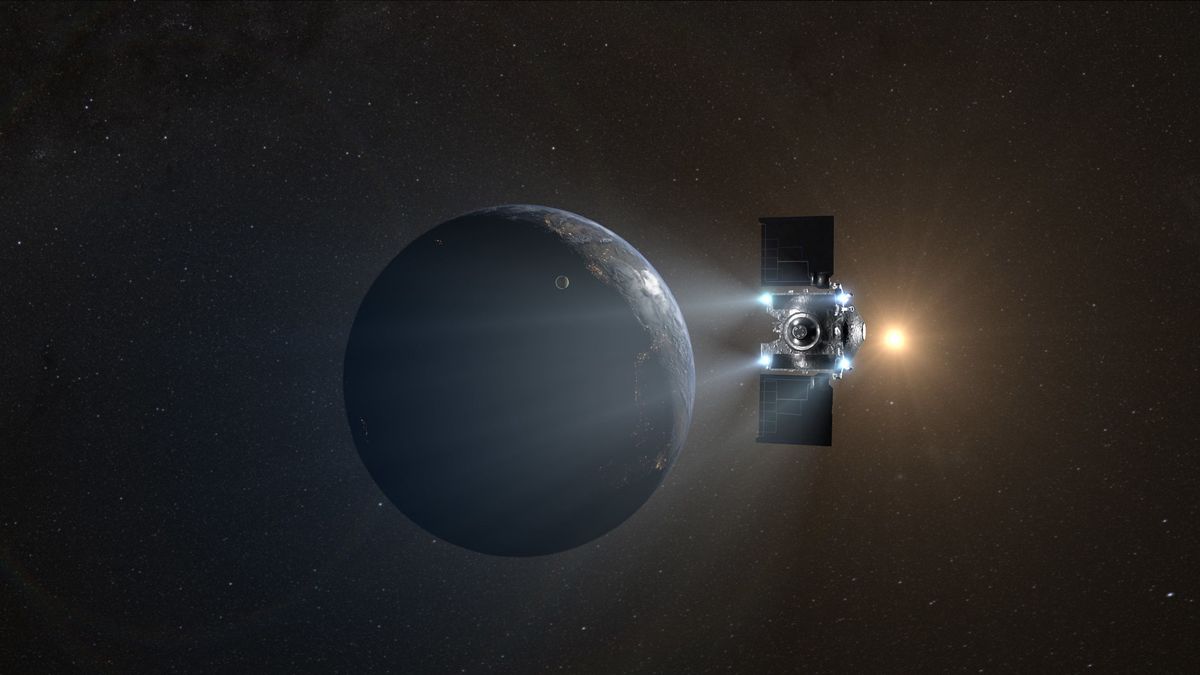NASA unveils surprising discovery after opening cannister of asteroid Bennu; Here’s what scientists found

NASA unveils surprising discovery after opening cannister of asteroid Bennu; Here’s what scientists found
NASA has achieved a significant milestone in its space exploration efforts by revealing the secrets of an asteroid’s sample that recently returned to Earth. This sample was collected from the ancient asteroid Bennu, and NASA has made notable discoveries from the black asteroid pieces it retrieved.
Two crucial ingredients have been identified from the samples, marking a significant scientific breakthrough. These discoveries are expected to provide valuable insights into the history and composition of asteroids and our solar system.
NASA’s efforts in studying asteroids like Bennu contribute to our understanding of the origins of celestial bodies and the conditions that existed in the early solar system. By analyzing the composition of asteroid samples, scientists can gain insights into the building blocks of our solar system and the potential role that asteroids may have played in the evolution of planets and life.
This achievement underscores the importance of space exploration missions in expanding our knowledge of the cosmos and advancing scientific research. NASA’s ability to collect and analyze samples from distant celestial bodies like Bennu represents a remarkable feat of technology and engineering, with profound implications for our understanding of the universe.
In a significant scientific breakthrough, NASA scientists have made a remarkable discovery after opening a canister containing a sample of the ancient asteroid Bennu. The sample, collected from the 4.5-billion-year-old asteroid, has revealed the presence of two fundamental ingredients: water and carbon.
This discovery is of immense importance as it sheds light on the composition and history of not only Bennu but also our solar system. The identification of water and carbon in the asteroid’s sample provides crucial insights into the conditions that prevailed in the early solar system and the role that asteroids like Bennu may have played in its evolution.
Water, a key component for life as we know it, has been detected within the asteroid sample. This finding raises intriguing questions about the potential presence of water on other celestial bodies and its significance in the context of astrobiology and the search for extraterrestrial life.
Carbon, another elemental building block of life, has also been found in the asteroid sample. The presence of carbon suggests that Bennu contains organic materials that may offer clues about the origins of life and the formation of complex molecules in the cosmos.
NASA’s ability to collect and analyze samples from Bennu represents a monumental achievement in space exploration and scientific research. It showcases the cutting-edge technology and expertise that enable the study of distant celestial bodies and their role in the formation of our solar system.
The study of asteroids like Bennu is critical for advancing our understanding of the universe’s history and the conditions that led to the emergence of life on Earth. These findings not only deepen our knowledge of the cosmos but also open up new avenues for exploration and the search for life beyond our planet.
NASA administrator Bill Nelson has announced a groundbreaking achievement, stating that the sample collected from the ancient asteroid Bennu is the largest carbon-rich asteroid sample ever brought back to Earth. This significant milestone was revealed at the Johnson Space Center in Houston, where the first images of the collected black dust and pebbles were unveiled.
The magnitude of this accomplishment cannot be overstated, as it represents a remarkable feat in space exploration. The successful retrieval of such a substantial and carbon-rich sample from an asteroid provides scientists with a wealth of invaluable material to study and analyze.
The study of this asteroid sample holds great promise for advancing our understanding of the solar system’s origins and the conditions that prevailed in its early stages. It also has the potential to provide insights into the formation of organic compounds, the building blocks of life, and the distribution of water and other essential elements in the cosmos.
The unveiling of these initial images is just the beginning of what promises to be a groundbreaking scientific journey. The data and samples collected from Bennu have the potential to reshape our knowledge of the universe and may hold answers to some of the most profound questions about our solar system’s history and the potential for life beyond Earth.
NASA’s successful mission to Bennu and the return of this carbon-rich asteroid sample exemplify the agency’s dedication to pushing the boundaries of space exploration and advancing our understanding of the cosmos. It represents a testament to human ingenuity, technology, and the spirit of scientific discovery.
NASA administrator Bill Nelson has provided valuable insights into the composition of the asteroid sample collected from Bennu. According to Nelson, carbon accounts for nearly 5% of the sample’s total weight, and it exists in various forms, including both organic and mineral components. Additionally, water has been identified within the crystal structure of clay minerals found within the sample.
These findings are of immense significance in the realm of planetary science and astrobiology. The presence of carbon, a fundamental building block of life, in both organic and mineral forms suggests that Bennu contains a diverse range of carbon-based materials. This diversity has the potential to provide vital clues about the formation and evolution of organic compounds in the early solar system.
The discovery of water locked within the crystal structure of clay minerals is equally noteworthy. Water is a critical ingredient for life, and its presence within the asteroid sample raises intriguing questions about the history of water in the solar system and its potential role in the development of habitable environments on other celestial bodies.
The identification of carbon and water within the Bennu sample underscores the scientific significance of this mission and the wealth of information it can provide about the origins of our solar system, the distribution of essential elements, and the potential for life beyond Earth.
These findings mark the beginning of a comprehensive scientific analysis of the asteroid sample, and researchers are poised to delve deeper into the intricacies of its composition to unlock further insights into the mysteries of the cosmos and our place within it.
The idea that Earth’s oceans, lakes, and rivers owe their existence to ancient water-carrying asteroids is a compelling hypothesis in planetary science. This theory suggests that during Earth’s early formation, it experienced numerous impacts from celestial bodies, including asteroids that contained water in the form of ice. These impacts contributed significant quantities of water to our planet, ultimately forming the bodies of water that are crucial for Earth’s habitability.
Water is a fundamental ingredient for life as we know it, and the presence of liquid water on Earth is a key factor that has allowed life to flourish. It provides a suitable environment for chemical reactions, serves as a solvent for essential biochemical processes, and plays a central role in various ecological systems.
Additionally, carbon is indeed the foundation of life on Earth. Carbon’s unique ability to form bonds with other elements, as well as its versatility in creating complex organic molecules, has allowed for the development of the diverse array of life forms and biological processes found on our planet. Proteins, enzymes, DNA, and RNA—all essential components of life—rely on carbon-based chemistry for their structure and function.
Understanding the origins of water and carbon on Earth is critical to unraveling the mysteries of how life emerged and evolved on our planet. These elements are fundamental to the processes that sustain life, making them central topics of study in fields such as planetary science, astrobiology, and the search for habitable environments beyond Earth.
NASA’s asteroid mission represents a significant milestone in space exploration. It marked the first United States mission designed to collect a sample from an asteroid and return it to Earth for analysis. The spacecraft embarked on this groundbreaking mission with the goal of studying the asteroid Bennu and gathering valuable samples from its surface.
The spacecraft successfully completed its mission, returning to Earth on September 24, 2023. This return marked a historic moment as it carried with it precious material collected from asteroid Bennu. While the spacecraft did not land on Earth, its mission continued with a new objective—to explore the asteroid Apophis.
The study of asteroids like Bennu and Apophis is essential for advancing our understanding of these celestial bodies, their composition, and their potential impact on Earth. By collecting samples from asteroids and studying them, scientists can gain critical insights into the early solar system, the origins of celestial bodies, and the potential risks and opportunities they pose.
NASA’s asteroid missions are a testament to human ingenuity, technology, and the spirit of exploration. They hold the promise of unlocking mysteries about the cosmos and Earth’s place within it. These missions also play a crucial role in planetary defense efforts by helping us better understand and prepare for potential asteroid impacts on our planet.
The continuation of the spacecraft’s mission to explore asteroid Apophis demonstrates NASA’s commitment to pushing the boundaries of space exploration and advancing our knowledge of the universe.
While NASA’s OSIRIS-REx mission to collect samples from the asteroid Bennu was a groundbreaking endeavor, it’s important to note that Japan had previously achieved asteroid rendezvous missions with success. Japan’s missions, Hayabusa and Hayabusa2, managed to rendezvous with asteroids and return celestial dust in 2010 and 2020, respectively. However, the amount of material collected during these missions was comparatively small, with Hayabusa2 returning only 5.4 grams of asteroid material.
In contrast, the OSIRIS-REx mission collected an estimated 250 grams (half a pound) of material from the asteroid Bennu, which significantly exceeds the samples brought back by the Japanese missions. This achievement marked a substantial leap in our ability to retrieve samples from asteroids for scientific study.
Asteroid Bennu, named after an ancient Egyptian deity, holds particular scientific interest because it is considered a “primordial artifact preserved in the vacuum of space.” Its composition and characteristics can provide valuable insights into the early solar system and the processes that shaped celestial bodies.
Moreover, Bennu’s orbit, which intersects with that of Earth, made the mission more accessible compared to journeys to the Asteroid Belt, located between Mars and Jupiter. This strategic choice allowed NASA to study an asteroid that was within closer reach.
NASA’s commitment to preserving at least 70% of the collected sample at Houston for future study follows a practice established during the Apollo era with Moon rocks. This approach ensures that future generations of scientists and researchers will have the opportunity to analyze and learn from the pristine material collected from Bennu, advancing our understanding of the cosmos and our place within it.




